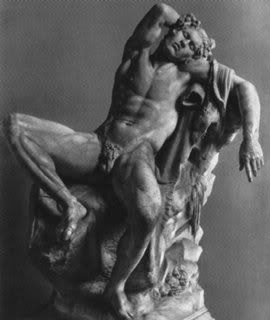
the first record of this sculpture of a drunken faun or satyr, created perhaps as early as the 3rd century b.c.e., is a 1628 bill, stating it belonged to cardinal francesco barberini.
barberini had earlier supported galileo, who was interrogated for subscribing to copernican astronomy, + later entertained the english puritan poet john milton.
both actions suggest the cardinal’s liberal humanism + willingness to distinguish secular from church interests, as does his role in founding the vatican library + encouraging the translation + study of non-christian asian + african texts.
the statue had been found in the early 1620s, missing parts of the head, both hands, + the right leg.
according to tradition, barberini’s uncle, pope urban viii, assigned the task of restoration to the artist bernini, who sculpted the baroque masterpiece the ecstasy of st. theresa + designed three famous roman fountains.
but no evidence corroborates this tradition.
there is evidence to support the theory that the statue was one of several statues removed from the emperor hadrian’s mausoleum + hurled down upon invading goths in the 6th century c.e., thus accounting for the extensive damages.
the faun’s face resembles the face of antinous, hadrian’s lover for six years, whose drowning at age 19 or 20 prompted hadrian to immortalize the handsome youth in statuary + coins throughout the roman empire.
roman sculptors depicted antinous in various roles + dress—as a priest, as bacchus, even as osiris—the image as common + versatile as barbie in 20th-century america.
that the faun’s face may be antinous’ would support a theory that the statue is roman, not greek, in origin.
some people think the 17th-century restorers of the statue may have enhanced its homoeroticism, as the pose is not typical of ancient greek or roman statuary.
not shy about admiring the nude male form, the greeks, nevertheless, probably would not have approved of the body’s unheroic slackness or its long penis, appropriate to a satyr, perhaps, but qualities greeks ridiculed, rather than idealized.
but nothing in the statue intrinsically invites ridicule.
critics have noted the obvious, that the pose accentuates the faun’s cock, but also, more subtly, the cock points downward, past a prominent testicle, to draw attention to the just detectable butt crack + the receding space’s insinuation of a receptive anus.
the upturned face, relaxed jaw, curly + disheveled hair, exposed armpits, + attractive pouch framing the navel also hint at sexual submissiveness + immediate availability.
these features are somewhat offset by the figure’s long toes, the hint of an adam’s apple, the prominent testicle, + protuberant veins on the hands + feet, all signs of a potential, if not immediately assertive virility.
the statue now resides in the glyptothek in munich.
No comments:
Post a Comment